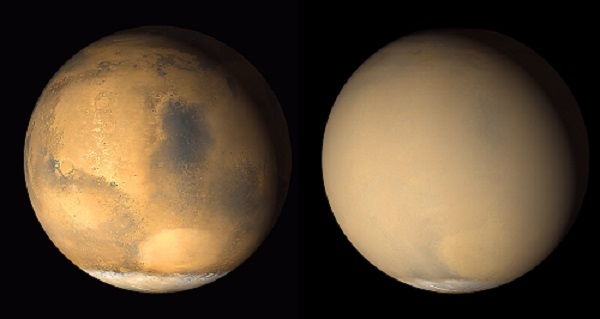RoadMap (for “ROle and impAct of Dust and clouds in the Martian AtmosPhere”), a brand new Horizon 2020 project, has just kicked off. Three years long an enthusiastic team of scientists and engineers from Belgium, Denmark, Germany, and Spain will work together to unravel some of the remaining Martian mysteries.
Mars: the unexplored territory
Credits: NASA/JPL/Caltech
If you are reading this, there is a high probability that you will agree with the premise that Mars is a fascinating planet. This despite the fact that there is not so much to see around there, at least not with the naked eye. A parade of rovers and landers have touched down on its surface, and all pictures they have sent back have revealed one thing: the abundance of dust. No matter in which direction they looked, Curiosity, InSight and their predecessors saw only a planet covered in rust-coloured dust, not only on the ground, in the atmosphere as well. Mars being the focus of future space exploration, both robotic and human, it is crucial we make a point of understanding the Martian atmosphere and climate even better than we do now.
Although dust is present throughout the Martian atmosphere, its abundance and physical properties are still poorly defined. Similarly, the impact of dust on the composition, structure and dynamics of the atmosphere is only beginning to be addressed. Specifically, accurate knowledge of the characteristics of dust and ice clouds is crucial for the interpretation of the remote sensing observations, both in the infrared and the ultraviolet spectral regions.
Explains RoadMap’s Principal Investigator, Dr. Ann Carine Vandaele of BIRA-IASB.
A multidisciplinary approach
RoadMap, a European Horizon 2020 project, has just kicked off the racing blocks with the objective to leap forward in respect to these knowledge gaps. RoadMap aims to deliver on these objectives thanks to a particular strategy. The strength of the project is that it not only brings together different teams of scientists from different countries, but in addition brings together experts from the specific fields that are necessary to tackle the Martian dust puzzle.
Three different angles of approach will be used simultaneously to look at the physical problem:
- Scientists in the laboratory community will create and define a new Martian dust analogue (a copy), in order to extract the best experimental data right here on Earth and work out the precise physical properties of the recreated Mars dust.
- Scientists involved in space missions to Mars know the intricacies and potential of their instruments, what knowledge has been and can be gathered from the planet itself.
- Scientists developing numerical models, like Global Circulation Models (GCM), know what data and information is pertinent to their models and how best to interpret their results.
These three approaches combined have the potential to answer many questions that have remained open about Mars: Why do we see considerable amounts of dust in the atmosphere event outside the dusty seasons? How do dust storms – which can sometimes envelop the entire planet at once – start, grow and end? Why are the dust storms so different in size from year to year?
RoadMap will improve our vision of the Martian atmosphere and provide a new generation of high-level data, increasing the science return of the past and current missions to Mars as well as shaping future planetary missions.

The RoadMap research teams
The Royal Belgian Institute for Space Aeronomy (BIRA-IASB, Belgium), the coordinator of the project, closely collaborates with teams from the Aarhus University (AU, Denmark), the Duisburg & Essen University (UDE, Germany), the Instituto de Ceramica y Vidrio (ICV-CSIC, Spain), and the Instituto de Astrofísica de Andalucia (IAA-CSIC, Spain), each bringing their own specific expertise to the RoadMap project.
BIRA-IASB will reinvestigate space data recorded using the improved laboratory radiative properties of dust and clouds.
We will focus on two European missions that are still active around the Red Planet. We will in particular make use of the ExoMars TGO instrument NOMAD, which has been optimized for the detection of trace gases, dust and ice clouds in the Martian atmosphere.
Says Dr. Vandaele. BIRA-IASB will also improve the 3D modelling of the Martian atmosphere through better parameterisations of the processes related to dust, like lifting and transport, and the radiative impact of dust.
The planetary environment facility at AU has the capability of recreating the conditions found close to the surface of Mars and will be used in order to study the generation and properties of Mars analogue aerosols, in close collaboration with UDE, ICV-CSIC and IAA-CSIC.
UDE will carry out experiments with different Martian simulants in view of characterizing the physical properties of dust particles lifted and their potential aggregation.
ICV-CSIC possesses the expertise to create and characterize the set of Martian dust analogue samples with shapes, sizes, and compositions representative for the Martian atmosphere in their laboratories.
IAA-CSIC will produce a unique database of experimental scattering properties of Martian dust analogues that will feed the radiative transfer model. Advanced numerical techniques validated on the experimental data will subsequently be used to produce a database of computed optical properties spanning the complete observational wavelength range.
 This project has received funding from the European Union’s Horizon 2020
This project has received funding from the European Union’s Horizon 2020
research and innovation programme under grant agreement No 101004052.


